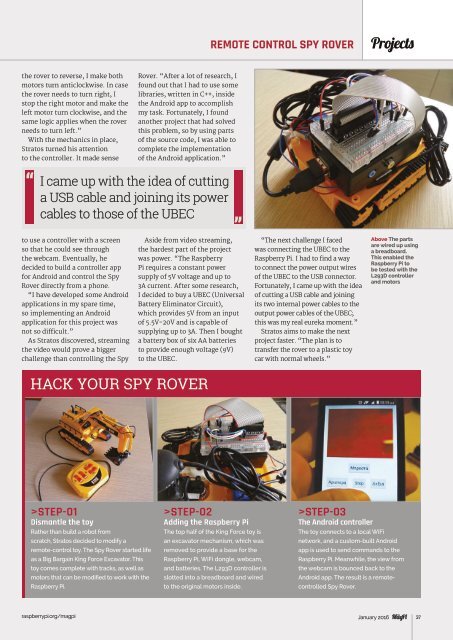You also want an ePaper? Increase the reach of your titles
YUMPU automatically turns print PDFs into web optimized ePapers that Google loves.
REMOTE CONTROL SPY ROVER<br />
Projects<br />
the rover to reverse, I make both<br />
motors turn anticlockwise. In case<br />
the rover needs to turn right, I<br />
stop the right motor and make the<br />
left motor turn clockwise, and the<br />
same logic applies when the rover<br />
needs to turn left.”<br />
With the mechanics in place,<br />
Stratos turned his attention<br />
to the controller. It made sense<br />
Rover. “After a lot of research, I<br />
found out that I had to use some<br />
libraries, written in C++, inside<br />
the Android app to accomplish<br />
my task. Fortunately, I found<br />
another project that had solved<br />
this problem, so by using parts<br />
of the source code, I was able to<br />
complete the implementation<br />
of the Android application.”<br />
I came up with the idea of cutting<br />
a USB cable and joining its power<br />
cables to those of the UBEC<br />
to use a controller with a screen<br />
so that he could see through<br />
the webcam. Eventually, he<br />
decided to build a controller app<br />
for Android and control the Spy<br />
Rover directly from a phone.<br />
“I have developed some Android<br />
applications in my spare time,<br />
so implementing an Android<br />
application for this project was<br />
not so difficult.”<br />
As Stratos discovered, streaming<br />
the video would prove a bigger<br />
challenge than controlling the Spy<br />
Aside from video streaming,<br />
the hardest part of the project<br />
was power. “The Raspberry<br />
Pi requires a constant power<br />
supply of 5V voltage and up to<br />
3A current. After some research,<br />
I decided to buy a UBEC (Universal<br />
Battery Eliminator Circuit),<br />
which provides 5V from an input<br />
of 5.5V-20V and is capable of<br />
supplying up to 3A. Then I bought<br />
a battery box of six AA batteries<br />
to provide enough voltage (9V)<br />
to the UBEC.<br />
“The next challenge I faced<br />
was connecting the UBEC to the<br />
Raspberry Pi. I had to find a way<br />
to connect the power output wires<br />
of the UBEC to the USB connector.<br />
Fortunately, I came up with the idea<br />
of cutting a USB cable and joining<br />
its two internal power cables to the<br />
output power cables of the UBEC;<br />
this was my real eureka moment.”<br />
Stratos aims to make the next<br />
project faster. “The plan is to<br />
transfer the rover to a plastic toy<br />
car with normal wheels.”<br />
Above The parts<br />
are wired up using<br />
a breadboard.<br />
This enabled the<br />
Raspberry Pi to<br />
be tested with the<br />
L293D controller<br />
and motors<br />
HACK <strong>YOUR</strong> SPY ROVER<br />
>STEP-01<br />
Dismantle the toy<br />
Rather than build a robot from<br />
scratch, Stratos decided to modify a<br />
remote-control toy. The Spy Rover started life<br />
as a Big Bargain King Force Excavator. This<br />
toy comes complete with tracks, as well as<br />
motors that can be modified to work with the<br />
Raspberry Pi.<br />
>STEP-02<br />
Adding the Raspberry Pi<br />
The top half of the King Force toy is<br />
an excavator mechanism, which was<br />
removed to provide a base for the<br />
Raspberry Pi, WiFi dongle, webcam,<br />
and batteries. The L293D controller is<br />
slotted into a breadboard and wired<br />
to the original motors inside.<br />
>STEP-03<br />
The Android controller<br />
The toy connects to a local WiFi<br />
network, and a custom-built Android<br />
app is used to send commands to the<br />
Raspberry Pi. Meanwhile, the view from<br />
the webcam is bounced back to the<br />
Android app. The result is a remotecontrolled<br />
Spy Rover.<br />
raspberrypi.org/magpi January 2016<br />
37


